Denmark and Croatia share common interests in various policy areas, visible and less visible, including security, defence, trade, transport, green transition and cultural exchanges.
H .E. Ole Henrik Frijs -Madsen, Ambassador of Denmark to Croatia, reveals to Diplomacy&Commerce magazine the plans for Denmark’s participation in COP28. About investments in Croatia, but also how he sees the EU in ten years find out in the rest of the interview.
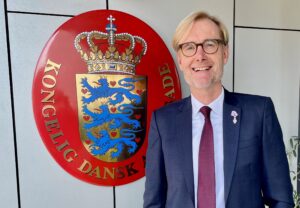
1. How do you assess the current relations between Croatia and Denmark, having in mind that both countries are members of the EU and NATO. Where do you see room for improving cooperation?
Improving cooperation is a constant in diplomacy and several avenues are being explored:
Trade and Economic Collaboration: Enhancing bilateral trade relations is achieved by identifying sectors for increased collaboration and investment. Exploring these opportunities leads to establishment of joint ventures in various fields i.e. technology, logistics or renewable energy. These elements strengthen economic ties.
Cultural Exchanges and Public diplomacy:
Engaging in and facilitating more cultural exchanges, collaborations between universities, conference platforms, actors in culture or NGO sector and think tanks, foster mutual understanding and people-to-people connections. We learn more and more about our societies and those roots we have established 31 years ago are being deepened.
Security and Defence Cooperation:
Strengthening collaboration within NATO frameworks by participating in joint military exercises, sharing best practices in defence technology and enhancing security in a physical sphere but also combating fake news online are beneficial for both of our states.
Environmental Initiatives:
Both countries have shown commitment to environmental sustainability. Collaborating in the field of green technologies, sharing best practices in sustainability and jointly addressing climate change issues are at the core of our current affairs.
Diplomatic and Political Dialogue:
Recent high-level visits, i.e. visit of the PM of Denmark Ms. Mette Frederiksen to Rijeka and Zagreb, diplomatic dialogue and exchange of visits between other officials is further contributing to a better understanding of each other’s perspectives and priorities, leading to stronger cooperation in afore mentioned domains. As relationships between nations evolve over time, it’s essential for Croatia and Denmark to continually assess areas where collaboration could be deepened or expanded for mutual benefit within the context of their EU and NATO memberships.
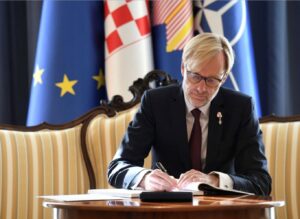
2. It seems that the political relations of the two countries are at the highest possible level. When we talk about the economy, what is the interest of investors to invest in Croatia and in which areas? What do the numbers show us when we talk about the economy (imports, exports, investments, tourism…)?
Talking in general terms, we have examined Croatian market and potentials and agreed on the following areas. Renewable Energy: There is a growing interest in renewable energy projects, including solar and wind energy, as Croatia aims to increase its share of renewable energy sources in its energy mix. This goes hand in hand with many highly specialised Danish companies with many years in research and development of renewable energy technologies which are tested and proven. Infrastructure:Investments in infrastructure development, including transportation, ports, railways and logistics, are areas where there is room for growth and improvement. At the same time, we have steady and successful companies operating in Croatia in Manufacturing: These are in our view stable industries in Croatia with highly skilled labour, which offer many opportunities. If the skill level is leveraged with still reasonable operating costs compared to some Western European countries, the formula for success is complete.
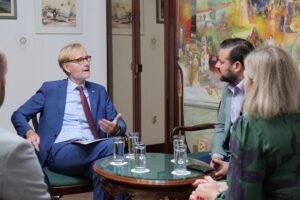
3. What projects and plans of the Embassy can you reveal to us that concern the improvement and consolidation of cooperation in the fields of culture, education, etc.?
The embassy engagement will continue in its usual three pillar approach: Cultural Exchanges: Organizing cultural events, exhibitions, film festivals, to promote Denmark’s culture, heritage and recent achievements. This involve showcasing Danish literature for example where we have this year had a promotion of a first CroatianDanish book of poems by Danish author Inger Christensen. Also, we have had a unique opportunity to host a world famous war photographer Jan Grarup who held lectures and presented his recent works in Zagreb and Rovinj.
Public diplomacy: The embassy was also a proud partner of Zagreb DOX and Zagreb film festivals displaying Danish movies. The icingon the cake for us this year was extensive cooperation with the city of Pula, uncovering joint historic ties through opening an exhibition of a Danish admiral Hans Birch Dahlerup but also hosting guests from Denmark who participated in a sustainable initiatives tour, Green Together exhibition opening and a panel discussion focusing on green transition and reducing our CO2 footprint. For the later part, we will continue into 2024. to use public diplomacy to facilitate and engage Croatian public especially in the fields of sustainability to promote mutual understanding and awareness of each other’s need to fight climate change. Third and not the least, Trade: The embassy will continue to provide assistance to Danish companies operating or planning to operate in Croatia for the mutual benefits of deepening our trade ties.
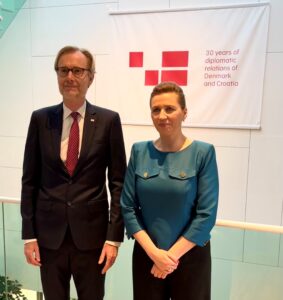
4. Which problems would you single out as the biggest in Europe, and what are the common policies to solve them?
Europe faces a range of complex challenges, and identifying the “biggest” problems can vary based on perspectives. However, some prominent issues often highlighted include: Migration and Refugee Crisis: Managing the influx of migrants and refugees, ensuring humane treatment, fair distribution across countries, and addressing the root causes driving migration are critical challenges. Climate Change and Environmental Sustainability: Mitigating the effects of climate change, transitioning to renewable energy, and adopting sustainable practices to preserve the environment are significant concerns. Security: Addressing security threats, both internal and external, including terrorism, cyber threats, and hybrid warfare, remains a priority. Demographic Shifts: Aging population in some European countries and declining birth rates pose challenges for social welfare systems and economic productivity. Strategic autonomy: Europe will be increasing its efforts to secure its own autonomy in the broad sense. That goes for energy, R&D, critical infrastructure, etc. We can expect more production to be near-shored or home-shored in the future. From this perspective the Corona pandemic – and our lack of own equipment, masks etc. – was a wake-up call for Europe. Solving these complex challenges requires a coordinated and comprehensive approach involving not only our governments but also civil society, businesses, and individuals working together within Europe and on the global stage. Flexibility, adaptability and a commitment to shared values and cooperation are essential to effectively tackle these issues.
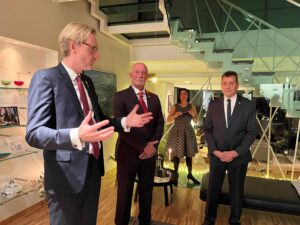
5. How do you see Europe and the EU in 10 years?
Despite the challenges mentioned, I am a firm believer in EU on all levels. In 10 years I do see a couple of main EU drivers progress; EU Expansion: The EU will very probably witness expansion with new member states joining, potentially from the Western Balkans or Eastern Europe, provided they meet the necessary criteria and reforms. Technological Advancements: Europe could be at the forefront of technological innovation, particularly in areas like renewable energy, digitalization and healthcare. Investments in research and development should be able to propel Europe’s position in global tech competition. Climate Leadership: The EU is likely to continue leading efforts to combat climate change, with more ambitious targets for carbon neutrality and sustainable practices across industries. Reforms and Integration: The EU might undergo reforms to strengthen integration, potentially in areas of defence and migration, to foster greater unity among member states. Geopolitical Role: Europe may aim to establish a more assertive geopolitical role globally, especially in technology and services, potentially increasing its autonomy. Europe is still to tackle social and demographic changes: It’s demographic landscape is evolving further, impacting policies related to aging populations, migration, and workforce dynamics. Overall, the EU’s trajectory in the next decade will likely be shaped by its ability to adapt to evolving challenges, capitalize on technological advancements, foster internal cohesion, and maintain its commitment to shared values while navigating a rapidly changing global landscape.
6.Danish participation in COP28 started at the end of November. What can you tell us about it?
As being a serious international technology provider and one of the most vocal countries to push for the fulfilment of the Paris agreement, Denmark goes to COP28 with a historically strong representation. As part of the largest ever Danish business delegation to the COP, Danish companies, organizations and investors are heading to the United Arab Emirates end of November to influence the future green course at COP28. Together with the Ministry of Climate, Energy and Supply, the Ministry of Foreign Affairs, Danish Industry and public-private partnership organisation State of Green, the Danish delegation will promote the pavilion were more than 40 events will take place. All with an eye to strengthening future public-private climate efforts. Thereby we ensure that Danish companies’ green initiatives are exposed to international players during COP28.